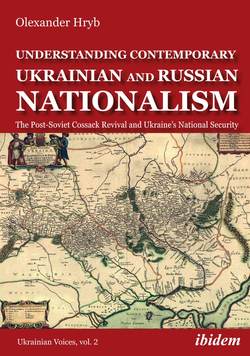Читать книгу Understanding Contemporary Ukrainian and Russian Nationalism - Olexander Hryb - Страница 18
2.1.4 Ethnic Consciousness—Optional or Crucial?
Оглавление“Primordialists” consider ethnic identity as similar to a national one, belonging to the multiplicity of contemporary and historical identities. Llobera observes that, for the greater part of human history, the twin circles of religious and ethnic identity have been very close and have sometimes overlapped with each other (Llobera 1994, 217). This, presumably, is one of the reasons why mythical imagination is as important for ethnic as it is for religious consciousness (Smith 1991a; Shkliar 1992, 217). Smith also considers the perennial existence of ethnic consciousness in the social development of mankind and its great importance for the formation of national consciousness. According to this approach it is ethnic identity that as a rule (first of all through its myths and memories) creates a basis for the formation of national identity.
“Modernists” do not assume any strict connections between ethnic and national consciousness. Gellner claims that only sometimes can ethnic consciousness be transformed, under pressure of the transition to industrialism, into a national one, but even in this case it substantially changes its nature according to new socio-economic conditions. This is almost the only crucial difference between the two visions.
Gellner argues that ethnic consciousness belongs rather to historical identities and survives into the industrial epoch only in marginal forms. That is why the destination of ethnic identity in modern times can proceed mainly in two directions. First, it can construct (through its loyalties and affiliations) the basis for the social consciousness of a new type. Then the substantially transformed and developed ethnic consciousness becomes a national one. Second, and more likely, ethnic consciousness mostly or totally disappears and dissolves into other identities of the new era.
On this subject the difference between “primordialist” and “modernist” is how they estimate the role of ethnic consciousness in nation-building. For the latter, ethnic consciousness is only an occasional substrate for the creation of the new identity needed for industrial society. For the former, ethnic identity is an active agent of new national identity as well as a new important element for the consolidation of national unity.
In this sense, the Soviet Ethnography approach, and the predominant current views of the Ukrainian scholars, is definitely in agreement with “primordialists.” First, ethnic consciousness (using the wider meaning of term) is considered to be an attribute of ethnos. Second, ethnic consciousness (in a narrow meaning) is not imagined to be excluded from a national one. According to Bromley, ethnic consciousness, as the other modern form of social consciousness, possesses its reflexive level not only on an individual, but also on a social level. This means that ethnic consciousness not only does not dissolve but actually develops. This statement is determined by a vision of ethnos as a dynamic system, i.e., a process, which was common for the Soviet tradition and is preserved by contemporary Russian scholars.8 An individual ethnic self-consciousness is believed to have its expression in reflexive ethnic affiliation and awareness of one’s own actions, motives and interests in this context. Collective imaginations about typical characteristics and achievements of the community represent the self-consciousness of ethnos. The latter can be fixed not only through personal expressions but also in impersonal ones, i.e., in other objective forms of social consciousness—language, folklore, art, scientific literature, norms of morality and law (Chesnokov 1991; Ionin 1996, chs. 4-6). The most formal expression of self-consciousness on the social level is considered to be a common ethnic name.
Ukrainian scholars consider ethnic consciousness on the individual level as a multitude of knowledges, attitudes and aspirations about the culture, tradition, values and self-identification with a group and within the context of other groups. The individual acquires this consciousness during the process of “ethnization,” i.e., personal or group experience. The structure of ethnic consciousness includes ethnic or national character, customs, ethnocentrism, ethnic feelings, ethnic self-consciousness, self-identity, and so on. Each of the elements is considered to be “quite a complicated psychological phenomenon with its own structural forms of expression, principles of functioning” (Mala 1996, 41). It seems that such a reference to a “psychological phenomenal nature” is an attempt to avoid further explanation of what all these concepts consist of, and in a way this is a common “escape” used by sociologists in general, not only Ukrainian scholars. Billig stressed the opposite tendency of social psychologists to explain the nature of human consciousness by reference to “sociological and cultural factors,” which can lead to a situation where there is a mutual and agreed misunderstanding between both sociologists and social psychologists (Billig 1995).
Ethnic identity is defined in the context of “Social Identity Theory,” i.e. as a form of self-categorization by individuals (Mala 1996, 35) or as a result of a set of similar identification processes (Boldetskaya 1996, 53). Ethnic identification is considered an important component of ethnic consciousness. It is understood as self-affiliation or acceptance of likeness to some ethnic group. This process develops by way of the individual adapting himself to the roots and fundamentals of an ethnic group (Mala 1996, 41). In this way, the differentiation of the two terms “ethnic identity” and “ethnic identification” is incomplete and not fully convincing, since social psychologists argue that individual ethnic identity does not always imply identification with a group in a cultural sense. Psychologists differentiate therefore between ethnicity as interrelation between ethnic groups and ethnic identity as a part of an individual’s wider identity process (Liebkind 1989, 28). This lack of coherence was partially admitted by another Ukrainian scholar, Olena Donchenko, who agreed that the “process of mass identification is a social phenomenon which is not entirely understood by sociologists” (Donchenko 1994, 167).
